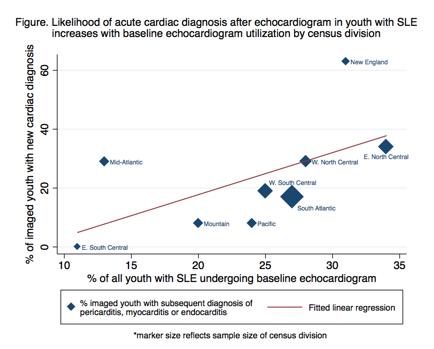Session Information
Date: Monday, November 6, 2017
Session Type: ACR Poster Session B
Session Time: 9:00AM-11:00AM
Background/Purpose: Child-onset systemic lupus erythematosus (SLE) is a chronic autoimmune condition with a high risk of organ damage. There are no guidelines on the use of echocardiography to detect cardiac manifestations. We aim to describe utilization of echocardiograms in youth with SLE, assess regional variation, and compare baseline echocardiogram use with subsequent rates of new cardiac diagnoses.
Methods: Using the ClinformaticsTM DataMart (OptumInsight, Eden Prairie, MN) de-identified US administrative claims data from 2000-2013, we identified youth ages 10-24 years with an incident diagnosis of SLE (≥3 ICD-9 SLE codes 710.0, >30 days apart). Multivariable logistic regression with forward selection was used to identify factors associated with echocardiogram use during the baseline period from 1 year preceding to 6 months after SLE diagnosis. Linear regression was used to evaluate the association between echocardiogram use by census division and the proportion of imaged youth subsequently diagnosed with their first acute cardiac manifestation (pericarditis, myocarditis, endocarditis), at or after the baseline echocardiogram.
Results: Among 699 youth with new-onset SLE, 26% underwent echocardiogram at baseline. Youth hospitalized at diagnosis had the highest odds of baseline echocardiogram (OR 6.1, 95%CI 3.8-9.8), while youth with psychiatric diagnoses had lower odds (OR 0.5, 95%CI 0.3-0.7) (Table). There was significant geographic variability in echocardiogram use by census division after adjustment for other subject characteristics. The prevalence of acute cardiac manifestations at any time in the total cohort was 10%, ranging from 0-19% by division. There was a positive linear association between the proportion of youth in each division undergoing echocardiography and the proportion of those imaged who were subsequently diagnosed with new acute cardiac manifestations (Figure).
Conclusion: There is significant geographic variability in the use of peri-diagnostic echocardiograms in youth with SLE. Divisions with more widespread use of baseline echocardiograms diagnosed greater proportions of imaged youth with new acute cardiac manifestations following echocardiography. The results suggest the low frequency of cardiac diagnoses in divisions using few echocardiograms may partially reflect under detection. This underscores the need to obtain echocardiograms in large numbers of unselected youth with SLE to determine whether routine echocardiography is warranted to identify cardiac disease that would otherwise be missed or manifest in an acute clinical setting.
To cite this abstract in AMA style:
Chang JC, Knight AM, Mercer-Rosa LM, Xiao R, Weiss PF. Geographic Variation in Use of Echocardiography at Diagnosis and Detection of Acute Cardiac Disease in Youth with Systemic Lupus Erythematosus [abstract]. Arthritis Rheumatol. 2017; 69 (suppl 10). https://acrabstracts.org/abstract/geographic-variation-in-use-of-echocardiography-at-diagnosis-and-detection-of-acute-cardiac-disease-in-youth-with-systemic-lupus-erythematosus/. Accessed .« Back to 2017 ACR/ARHP Annual Meeting
ACR Meeting Abstracts - https://acrabstracts.org/abstract/geographic-variation-in-use-of-echocardiography-at-diagnosis-and-detection-of-acute-cardiac-disease-in-youth-with-systemic-lupus-erythematosus/


